
The Osprey class was a Royal Navy class of screw-driven sloops built between 1874 and 1877. Nine additional ships were built to a revised design, the Doterel-class sloop. They were the first class of ship in the Royal Navy to use glass scuttles.
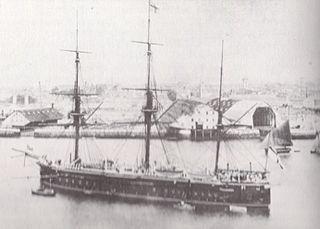
HMS Swiftsure was the lead ship of the Swiftsure class battleships built in the late Victorian era. Her sister-ship was HMS Triumph.
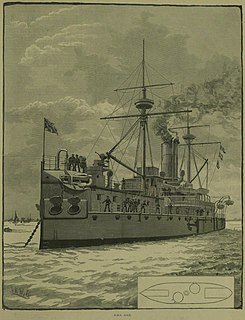
HMS Ajax was the name ship of her class of ironclad battleships built for the Royal Navy during the 1870s. Completed in 1883, she was immediately placed in reserve until 1885 when the ship was commissioned for the first time. Later that year, Ajax was assigned as a coast guard ship in Scotland and remained there for the next six years. She was reduced to reserve again in 1891 and was taken out of service a decade later. The ship was sold for scrap in 1904 and subsequently broken up.

The Amazon class was a class of six screw sloops of wooden construction built for the Royal Navy between 1865 and 1866.

The Mariner class was a class of six 8-gun gunvessels built for the Royal Navy between 1883 and 1888. Four were built in the Naval Dockard at Devonport, and two elsewhere; the Acorn was built by contract at Jacobs Pill on the Pembroke River, while the Melita was built in the Malta Dockyard, the only substantial ship of the Royal Navy ever to be built in the island.
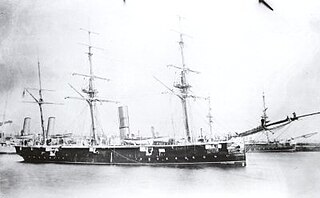
The Satellite class was a class of 12-gun composite sloops built for the Royal Navy between 1883 and 1888, and reclassified as corvettes in 1884.

The Eclipse class was a class of seven 6-gun wooden screw sloops built for the Royal Navy between 1867 and 1870. They were re-armed and re-classified as 12-gun corvettes in 1876. Two further vessels were proposed but never ordered.

The Comus class was a class of Royal Navy steam corvettes, re-classified as third-class cruisers in 1888. All were built between 1878 and 1881. The class exemplifies the transitional nature of the late Victorian navy. In design, materials, armament, and propulsion the class members resemble their wooden sailing antecedents, but blended with characteristics of the all-metal mastless steam cruisers which followed.

HMS Hyacinth was an 8-gun Satellite-class composite sloop built for the Royal Navy, launched in 1881 and sold in 1902. She and the rest of her class were re-classified as corvettes in 1884.

HMS Druid was a Briton-class wooden screw corvette built for the Royal Navy in the late 1860s. She spent her service life overseas on the Cape of Good Hope and North America and West Indies Stations and was sold for scrap in 1886.
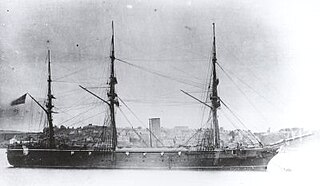
HMS Amethyst was the lead ship of the Amethyst-class corvettes built for the Royal Navy in the early 1870s. She participated in the Third Anglo-Ashanti War in 1873 before serving as the senior officer's ship for the South American side of the South Atlantic. The ship was transferred to the Pacific Station in 1875 and fought in the Battle of Pacocha against the rebellious Peruvian ironclad warship Huáscar two years later. This made her the only British wooden sailing ship ever to fight an armoured opponent. After a lengthy refit, Amethyst again served as the senior officer's ship on the South American station from 1882 to 1885. She was sold for scrap two years later.
The Briton class was a group of three wooden screw corvettes built for the Royal Navy in the late 1860s. All three ships of the class only served overseas during their brief service lives. Between them, they were assigned to the China, East Indies, African, North American, and the Pacific Stations. All three were regarded as obsolete 15 years after they were completed, and they were sold in 1886–87.

The Plover-class gunvessels were a class of wooden gunboats built for the Royal Navy in the late 1860s. They mostly served overseas and were retired early as they were regarded as hopelessly obsolete by the late 1880s.
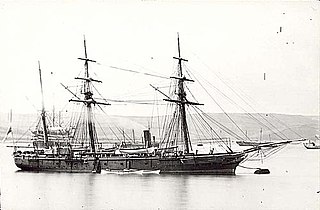
The Arab-class gunvessels were a pair of composite gunboats built for the Royal Navy in the mid-1870s.

HMS Lily was an Arab-class composite gunvessel built for the Royal Navy. She was launched in 1874, saw service in Chinese and North American waters, and was wrecked on the coast of Labrador on 16 September 1888.
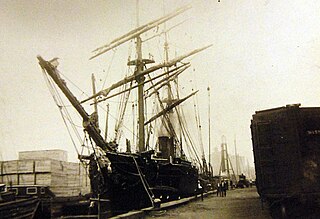
HMS Pelican was an Osprey-class sloop built for the Royal Navy in the mid-1870s. She was launched in 1877 and was sold to the Hudson's Bay Company in 1901. She was scuttled in 1953.

The Beacon-class gunvessels were a class of composite gunboats built for the Royal Navy in the late 1860s. They were the first warships of the Royal Navy expressly designed to use the engines of an older class of ships with a different hull shape. They were generally deployed overseas to the China, East Indies, West Africa, Pacific, North America and West Indies Stations. In addition to showing the flag, the ships fought pirates and suppressed the slave trade in East and West Africa. As their engines wore out in the mid-1880s, they were mostly retired and scrapped by the end of the decade. A few survived into the early 1900s as they were modified for harbour service before being sold or scrapped.
The Frolic-class gunvessels were a class of composite gunboats built for the Royal Navy in the early 1870s. They were generally deployed overseas to the East Indies, West Africa, and China Stations. In addition to showing the flag, the ships fought pirates and suppressed the slave trade in East Africa. They were placed in reserve in the mid-1880s, and two of them were sold for scrap by the end of the decade. The other pair survived for longer as they were either modified for harbour service or became a training ship before being sold or scrapped. The last survivor, Ready, was used in support of William Beebe's expedition in his bathysphere in 1930 off Bermuda.

The Emerald-class corvettes were a class of six composite screw corvettes built for the Royal Navy in the mid-1870s. The Opal was built by contract under the 1873-74 Programme, and Turquoise, Ruby, Tourmaline and Emerald under the 1874-75 Programme - the first three also by contract, while Emerald was dockyard-built at Pembroke. The final ship (Garnet) was also dockyard-built at Chatham under the 1875-76 Programme.

HMS Canada was a Comus-class screw corvette of the Royal Navy. She was launched in 1881 and sold for scrap in 1897. Her bow badge was removed prior to being sold for scrap and is displayed in the Maritime Museum of British Columbia.


















